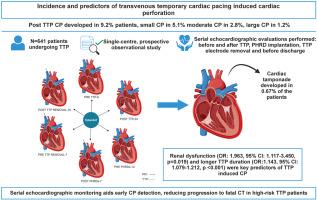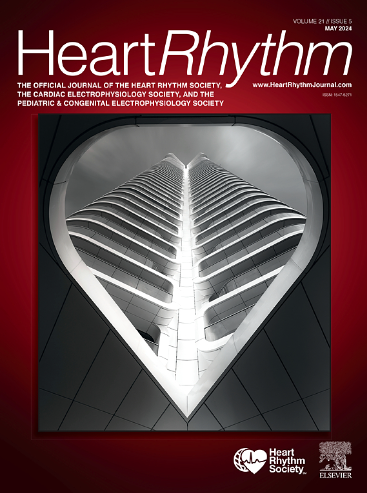临时起搏器植入诱发心脏穿孔的发生率及预测因素。
IF 5.7
2区 医学
Q1 CARDIAC & CARDIOVASCULAR SYSTEMS
引用次数: 0
摘要
背景:心脏穿孔(CP)和心包填塞(CT)是经静脉临时心脏起搏(TTP)的罕见但可怕的并发症,其发病率和对发病率和死亡率的影响报道不一。连续超声心动图在准确检测这些并发症中的作用尚未得到全面的研究。目的:本研究旨在通过连续超声心动图成像确定TTP后CP和CT的发生率,评估CP和CT的发展时间表,并确定预测因素。方法:2015年1月至2019年12月,在印度北部一家三级医院进行了一项单中心前瞻性观察性研究。共研究了641例连续接受TTP的患者。在多个预定时间点进行连续超声心动图评估:TTP前后、永久性心律装置(PHRD)植入后、TTP取出前、TTP电极取出后和出院前。排除已有心包积液(PE)或需要心肺复苏的患者。单因素和多因素Cox回归分析确定CP和CT的预测因素。结果:CP的发生率为9.2%。小、中、大积液分别为5.1%、2.8%和1.2%。连续超声心动图分别在3.7%、1.1%和2.3%的患者在TTP电极植入后、临时电极移除前和临时电极移除后发现新的积液。肾功能不全和TTP持续时间较长是CP的重要预测因素。结论:在TTP过程中使用连续超声心动图作为常规监测工具有助于提高CP和CT的早期发现。本文章由计算机程序翻译,如有差异,请以英文原文为准。

Incidence and predictors of temporary pacemaker implantation–induced cardiac perforation
Background
Cardiac perforation (CP) and cardiac tamponade (CT) are rare but dreaded complications of transvenous temporary pacing (TTP), with variable reported incidences and impacts on morbidity and mortality. The role of serial echocardiographic imaging in accurately detecting these complications has not been comprehensively investigated.
Objectives
This study aimed to determine the incidence of CP and CT after TTP using serial echocardiographic imaging, assess the timeline of CP and CT development, and identify predictors of CP and CT.
Methods
A single-center, prospective, observational study was conducted at a tertiary care hospital in North India from January 2015 through December 2019. A total of 641 consecutive patients undergoing TTP were studied. Serial echocardiographic evaluations were performed at multiple predefined time points: before and after TTP, after permanent heart rhythm device implantation, before TTP electrode removal, after TTP electrode removal, and before discharge. Patients with preexisting pericardial effusion or those requiring cardiopulmonary resuscitation were excluded. Univariate and multivariate Cox regression analyses were performed to determine the predictors of CP and CT.
Results
CP was observed in 59 (9.2%) patients. Small, moderate, and large effusions were observed in 33 (5.1%), 18 (2.8%), and 8 (1.2%) patients, respectively. Serial echocardiographic imaging detected new effusions in 3.7%, 1.1%, and 2.3% of patients after TTP electrode implantation, before temporary electrode removal, and after temporary electrode removal, respectively. Renal dysfunction and longer TTP duration were found to be significant predictors of CP.
Conclusion
The use of serial echocardiographic imaging as a routine monitoring tool during TTP procedures enhances the early detection of CP and CT.
求助全文
通过发布文献求助,成功后即可免费获取论文全文。
去求助
来源期刊

Heart rhythm
医学-心血管系统
CiteScore
10.50
自引率
5.50%
发文量
1465
审稿时长
24 days
期刊介绍:
HeartRhythm, the official Journal of the Heart Rhythm Society and the Cardiac Electrophysiology Society, is a unique journal for fundamental discovery and clinical applicability.
HeartRhythm integrates the entire cardiac electrophysiology (EP) community from basic and clinical academic researchers, private practitioners, engineers, allied professionals, industry, and trainees, all of whom are vital and interdependent members of our EP community.
The Heart Rhythm Society is the international leader in science, education, and advocacy for cardiac arrhythmia professionals and patients, and the primary information resource on heart rhythm disorders. Its mission is to improve the care of patients by promoting research, education, and optimal health care policies and standards.
 求助内容:
求助内容: 应助结果提醒方式:
应助结果提醒方式:


